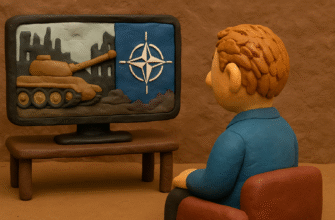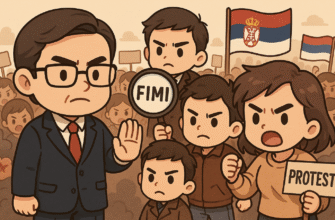Modern manipulations have long ceased to be a set of disparate fake news. They represent carefully planned operations with a well-thought-out chronology, strategically selected narratives, and synchronized activity across multiple channels. Identifying such campaigns by analyzing only the content of individual messages is practically impossible.
This pilot work presents a comprehensive methodology for identifying and analyzing coordinated disinformation campaigns, based on a combination of machine learning technologies, natural language analysis, and network analysis. The proposed approach allows not only to identify individual disinformation narratives but also to reveal their systemic interconnections, indicating coordinated campaigns.
The key distinction of the presented methodology is the integration of algorithmic methods of vectorization and content clustering with expert analysis, built on the capabilities of modern large language models (LLMs). This allows for efficient processing of large amounts of data while maintaining high accuracy in evaluating and interpreting identified patterns.
Methodology for Analyzing Disinformation Campaigns
- Narrative Vectorization:
The BERT model (DeepPavlov/rubert-base-cased) is used to obtain embeddings of narrative texts. If unavailable — TF-IDF is applied.
Result: numerical vectors of dimension 768 or up to 1000 features (TF-IDF). - Narrative Clustering:
Narratives are grouped into clusters by semantic similarity:DBSCAN— main algorithm (based on cosine metric)Agglomerative Clustering— alternative option
Parameters: similarity threshold ≥ 0.7, minimum 3 narratives per cluster
- Campaign Identification:
Clusters are combined into campaigns if:- they fall within a common time window (up to 30 days)
- they have ≥30% common channels
Campaigns are additionally filtered by reach, confidence, and duration.
- Network Analysis of Channels:
A graphG = (V, E)is constructed, where:- V — channels participating in campaigns
- E — presence of common campaigns
Calculated:
- centralities: degree, betweenness, eigenvector
- influence index: 0.4×Degree + 0.3×Betweenness + 0.3×Eigenvector
- modular communities and bridge channels between them
- In-depth Analysis with LLM:
GPT-4 or Claude models are used for expert campaign analysis.
LLM receives a prompt with:- general campaign statistics
- top 10 channels by videos
- examples of narratives (type, technique, confidence)
And answers the following questions:
- Is this a coordinated campaign?
- What are the disinformation strategies and tactics?
- What themes unite the narratives?
- Are there signs of coordination between channels?
- What is the potential effect of the campaign?
- What recommendations for counteraction?
Results are integrated into the report.
Based on detailed analysis of media content for the period from 01.03.2025 to 03.04.2025, three coordinated disinformation campaigns were identified with a total coverage of 59 videos, distributed through 5 media channels. The total reach of these campaigns exceeded 2.1 million views. For the analysis, rather strict parameters were set: at least 5 videos in a campaign (default is 3 videos), similarity threshold – 0.9 (default is 0.7).
Structure and Chronology of Campaigns
The first graph demonstrates the overall temporal dynamics of three disinformation campaigns in the period from early March to early April 2025:

- Campaign 1 (blue line) shows stable activity from early March, with a sharp peak on March 25, when the number of videos reached 15. Activity then drops sharply.
- Campaign 2 (red line) demonstrates wave-like activity in the first half of March with two pronounced peaks (March 7 and March 10), after which it gradually fades by mid-month.
- Campaign 3 (green line) begins exactly on March 26, immediately after the inauguration, and maintains stable activity until early April.
The most important detail of the graph is the vertical red line, denoting March 25, the day of the inauguration. Notably, this day sees the maximum peak of activity for the first campaign, after which there is a sharp change in pattern — Campaign 1 activity ceases and Campaign 3 begins.
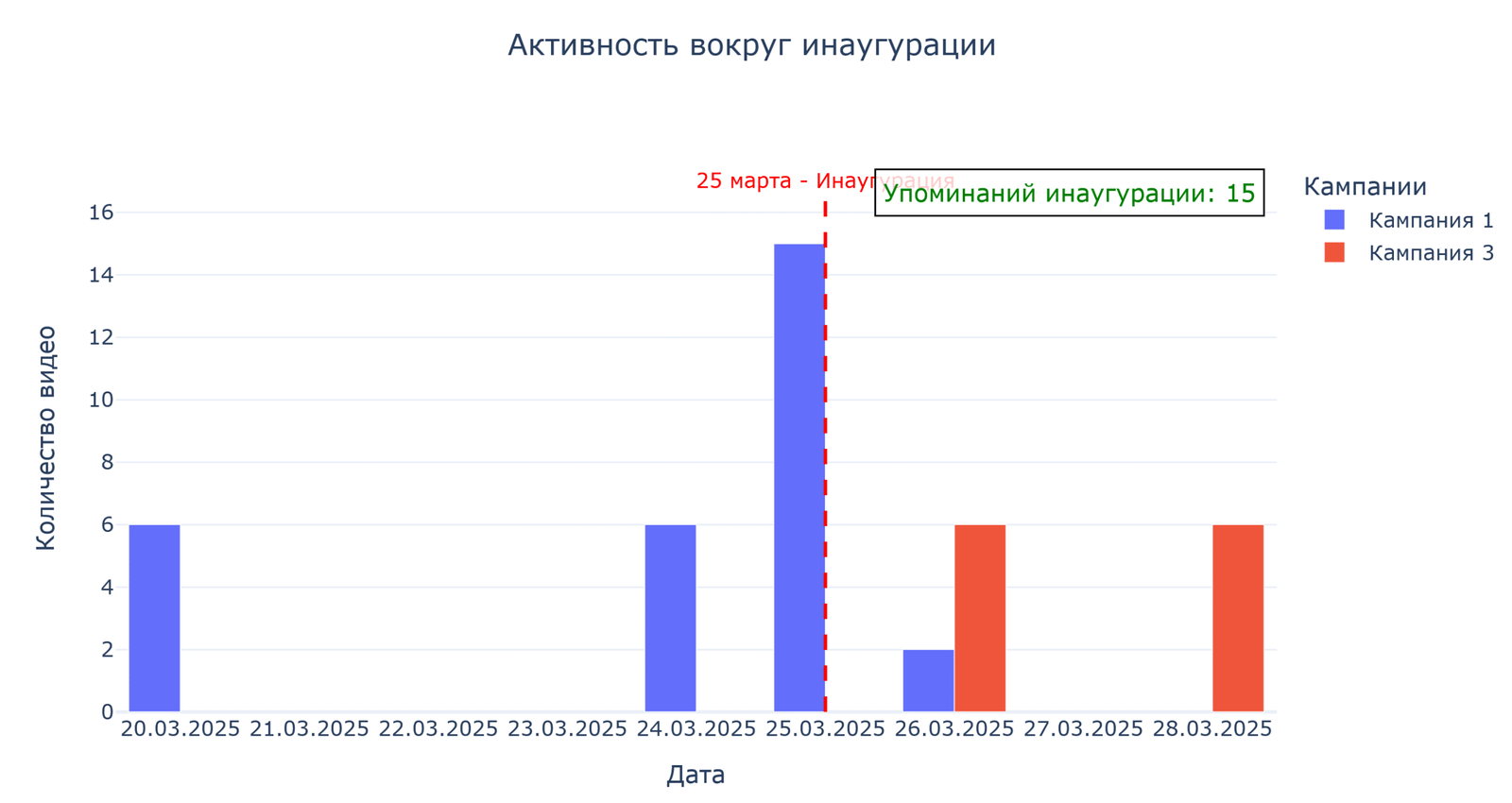
The second graph presents a detailed analysis of video activity in the period immediately around the inauguration (March 20-28):
It is significant that Campaign 1 reaches its absolute maximum (15 videos) precisely on March 25 — the day of the inauguration. There is a clear shift in activity after the inauguration date: Campaign 1 sharply declines, while Campaign 3 begins its activities.
Key Findings
- Coordination of Actions: The sharp change in activity exactly on the day of the inauguration indicates a high degree of coordination between channels. Such a coincidence is unlikely to be accidental.
- Shift in Narratives: The inauguration became a central informational occasion (15 videos on the day of the inauguration mentioning the event).
- Redirection of Disinformation: Strategically important is that immediately after the inauguration, a campaign shift occurred — this may indicate a deliberate change in narratives and the focus of disinformation after an important political event.
- Preparation for the Event: Notably, Campaign 1 activity remains stable during the week before the inauguration (6 videos per day), which may indicate preparation of the audience for the event.
Key Event: Inauguration on March 25, 2025
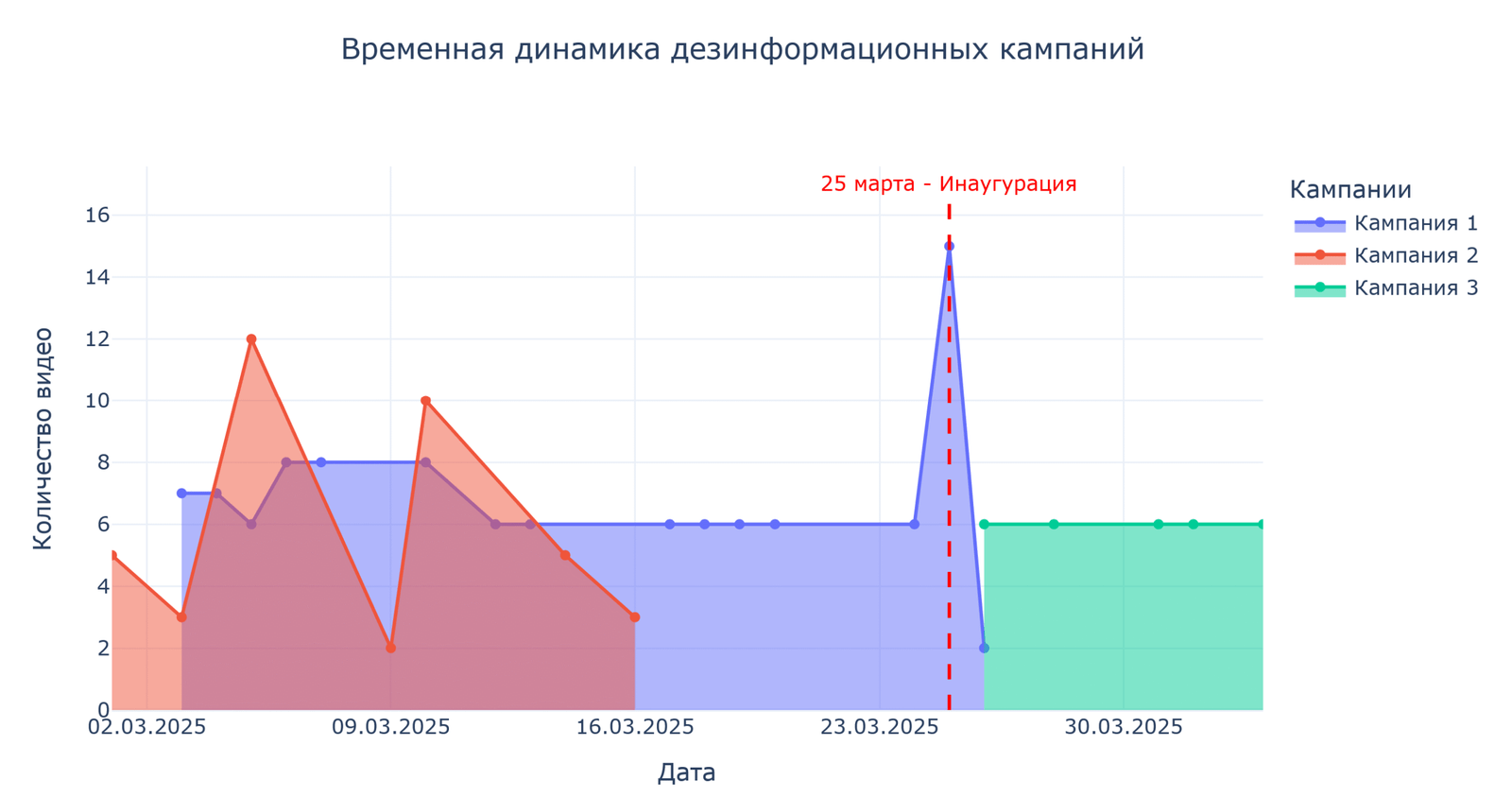
This indicates a high degree of coordination of actions and strategic planning of information activity before, during, and after a key political event.
Network Analysis and Channel Coordination
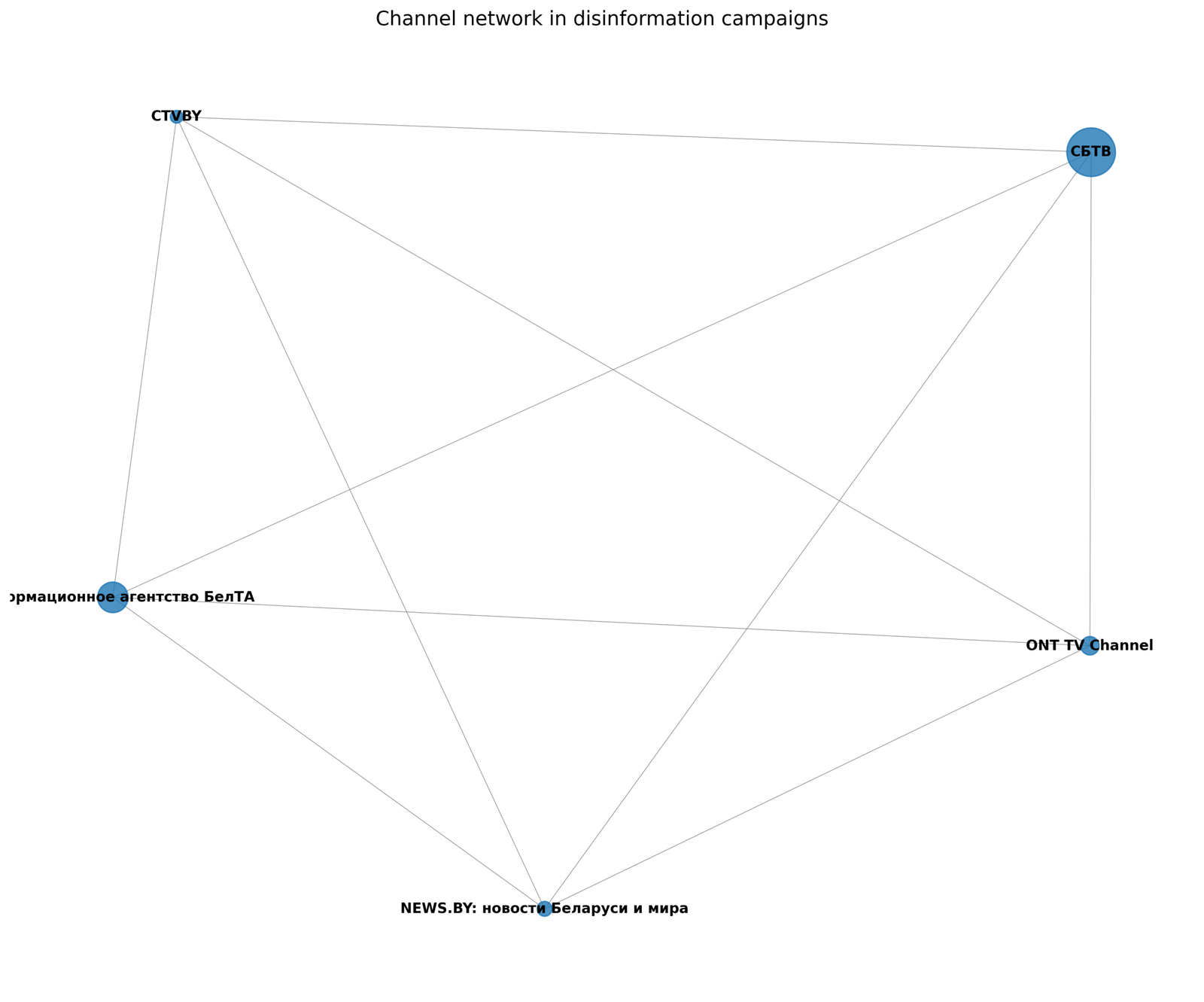
Analysis of the interconnections between channels shows:
- All 5 channels form a single interconnected network
- Key nodes: SBTV (38 videos), BelTA Information Agency (14 videos)
- SBTV channel participated in both Campaign 1 and fully provided Campaign 3
- Channels demonstrate synchronized activity, especially during the period of campaign shifts
The structure of interconnections indicates centralized coordination, possibly from a single source, which is a typical sign of a purposeful disinformation operation.
Analysis of Narratives and Influence Techniques
Distribution of Narrative Types

Content analysis revealed dominant types of disinformation narratives:
- Manipulation — 20.2% (38 mentions)
- Polarization — 18.6% (35 mentions)
- Emotional Exploitation — 11.2% (21 mentions)
- Anti-elitism — 9.0% (17 mentions)
- Global Conspiracy — 8.5% (16 mentions)
Confidence Level in Narrative Identification
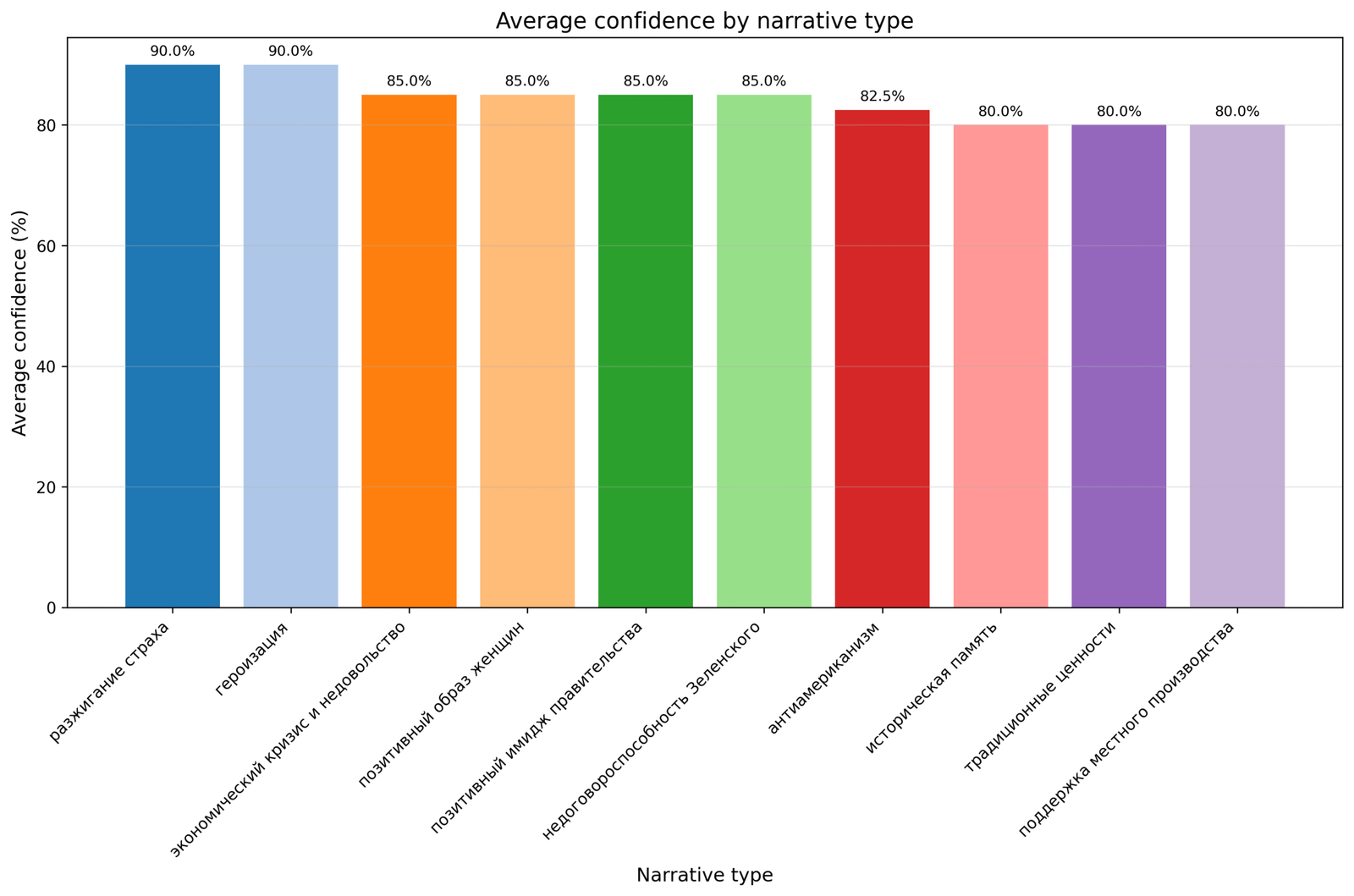
The average confidence graph by narrative types shows a high degree of classification reliability (80-90%), especially for “fear-mongering” and “heroization” narratives (90%).
Lexical Analysis of Narratives
Word clouds reveal the specifics of influence strategies:
- Emotional Exploitation: emphasis on “fear,” “emotionally charged language,” “creating a negative image”
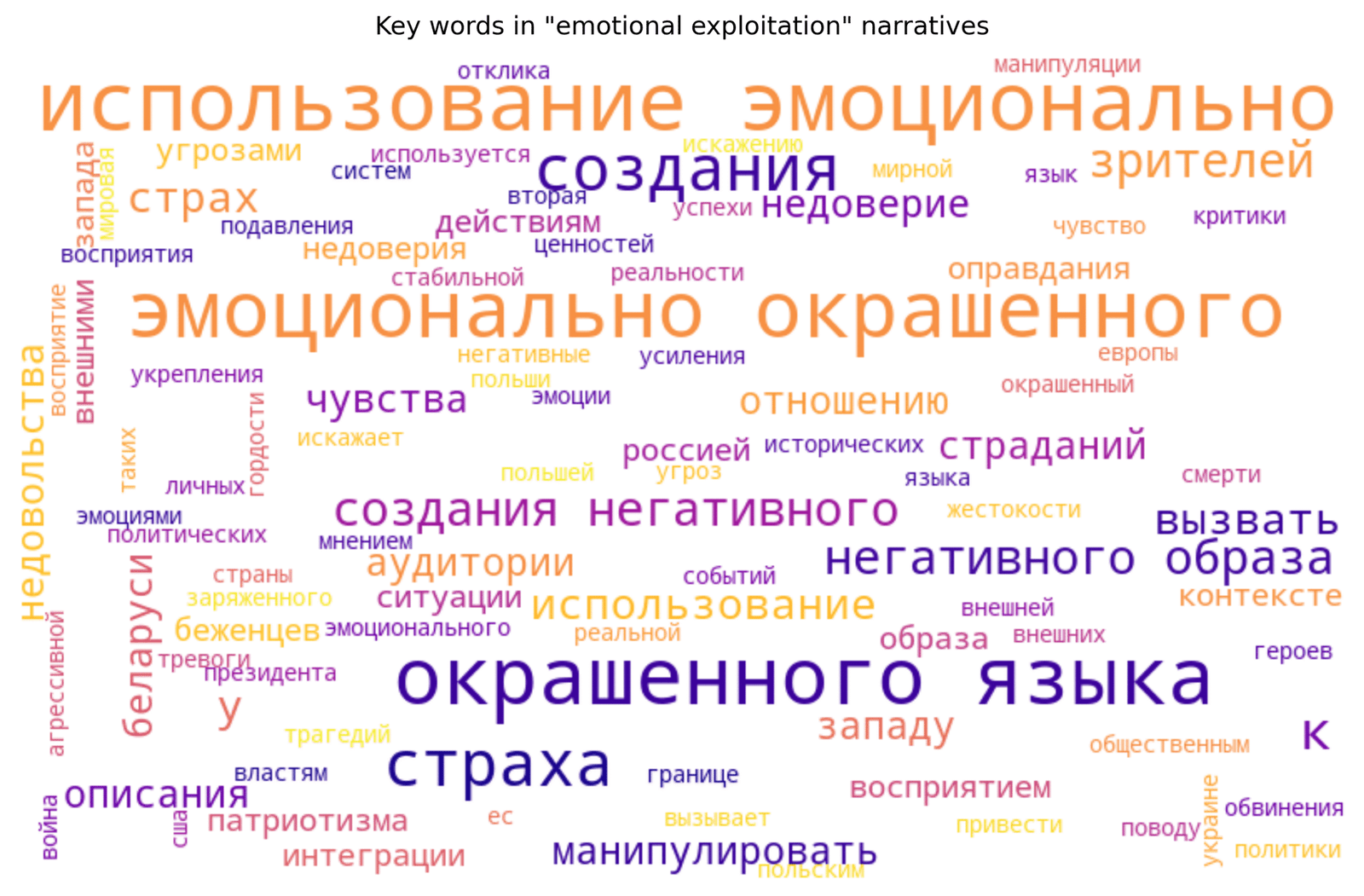
- General Disinformation Narratives: key concepts “Belarus,” “Lukashenko,” “USA,” “West,” “distortion of facts”

- Manipulation: dominants “distortion of facts,” “it is claimed,” “video is present”
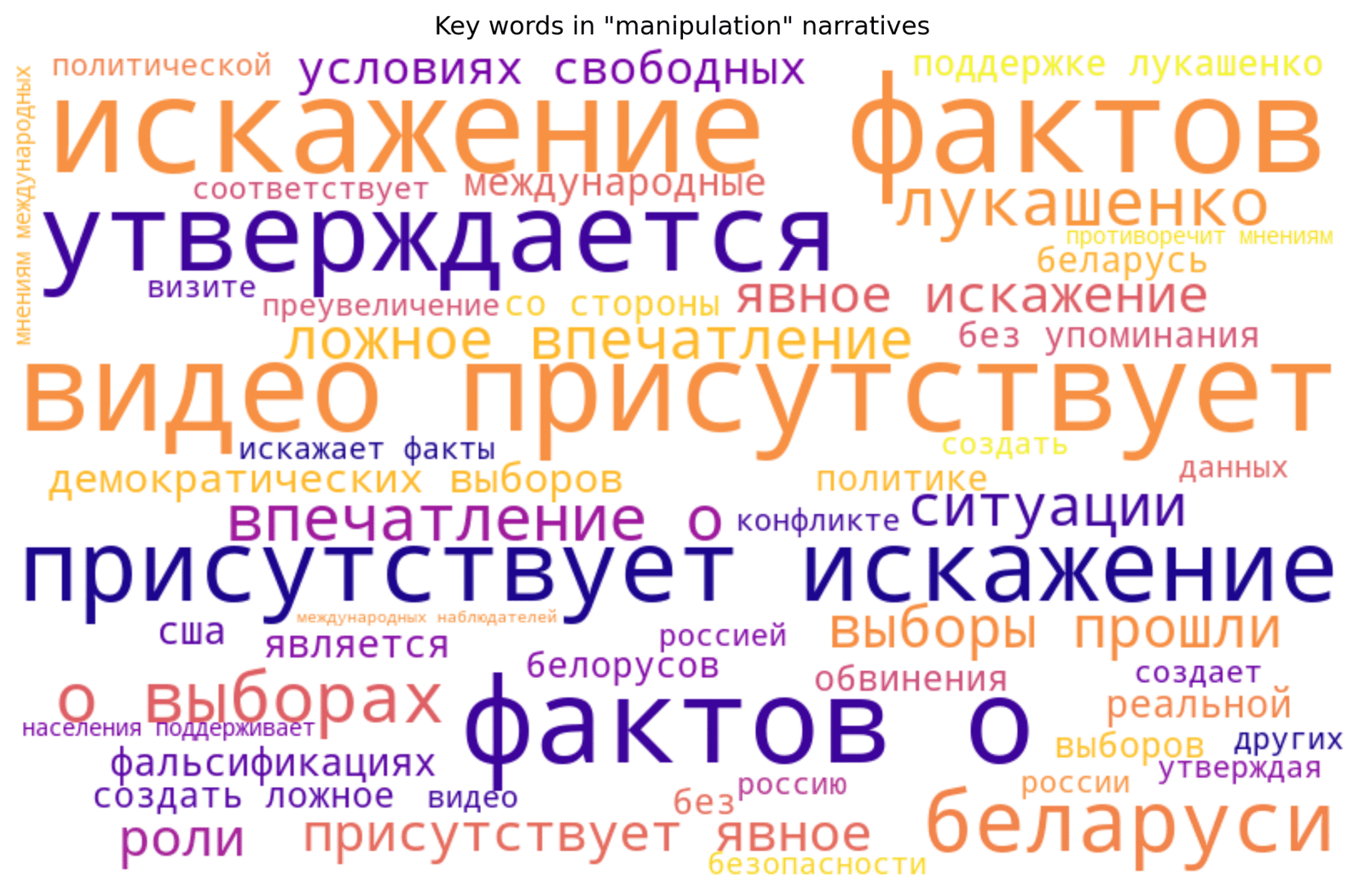
- Polarization: focus on “creating an image,” “against,” “division,” “Belarus vs West”

- Anti-elitism: based on “Western elites,” “manipulate,” “USA,” “criticism”

- Global Conspiracy: narratives about “Western countries,” “Russia,” “Ukraine,” “alleged conspiracy”

Analysis of Disinformation Campaigns
Campaign 1
Period: 03.03.2025 – 26.03.2025 (22 days)
Number of videos: 34
Number of channels: 5
Total number of views: 978764
Average confidence in disinformation: 69.6%
Examples of narratives:
-
Examples of narratives:
- It is emphasized that Western elites and corporations manipulate public opinion and finances for their interests, which leads to worsening lives for ordinary people.
- Lukashenko’s interview is presented as a revelation that destroys myths about Belarus created by Western elites.
- Skepticism and criticism of the US and their influence on Ukraine, emphasizing Ukraine’s dependence on American policy.
1. Is this a coordinated disinformation campaign? Why do you think so?
Yes, it appears to be a coordinated disinformation campaign. This conclusion is supported by the following indicators:
Multiple channels: The campaign uses five different channels, which is a common tactic in disinformation campaigns to amplify messages and reach different audiences
High volume of content: 34 videos created over 22 days, the frequency and volume of content indicate deliberate efforts to saturate the information space.
Aligned themes and narratives: The videos have common themes and storylines, suggesting strategic alignment of messages across different platforms.
High average disinformation confidence: The average disinformation confidence of 70% suggests that the content is deliberately misleading, characteristic of coordinated disinformation efforts.
2. What are the main disinformation strategies and tactics used?
The campaign employs several strategies and tactics, including:
Emotional provocation: Many videos use emotional appeals that evoke strong feelings such as fear, anger, or patriotism to manipulate audience perception.
Distortion of facts: Widespread use of fact distortion, where information is selectively presented or distorted to support the campaign’s narratives.
Demonization and dehumanization: Certain narratives aim to dehumanize opponents (e.g., portraying Ukraine as a victim of manipulation), which can foster hostility and division.
Conspiracy theories: The campaign promotes conspiracy theories, particularly regarding Western elites and their alleged manipulation of global events.
Polarization: Content is designed to deepen societal divisions, especially between pro-Western and pro-Russian sentiments.
3. What common themes and narratives unite these videos?
The videos are united by several common themes:
Anti-elitism: A strong narrative against Western elites and corporations, portraying them as manipulative forces harming ordinary people.
Anti-Americanism: Criticism of the United States, especially regarding its influence in Ukraine and role in international conflicts.
Historical memory: References to historical events are used to frame current narratives, especially regarding Belarus and Ukraine.
Technological sovereignty and local support: Emphasis on supporting local production and innovation, aligning with nationalist sentiments.
Societal division: Many narratives are aimed at creating or reinforcing divisions in society, especially between different political or ideological groups.
4. Are there signs of coordination between channels? If so, what are they?
Yes, there are signs of coordination between channels:
Dominance of SBTV: This channel produced the majority of the videos (28 out of 34), suggesting it may serve as the primary vehicle for the campaign’s messages.
Same content across channels: The narratives and themes align across all channels, suggesting they may be sharing content or strategies.
High viewership on key channels: Channels like BelTA Information Agency and ONT TV Channel have significant viewership numbers, indicating they are likely part of coordinated efforts to extend the campaign’s reach.
5. Assess the potential impact and scale of this campaign.
The potential impact of this campaign is significant due to:
High viewership: With almost 1 million views of the 34 videos, the campaign has the ability to reach a large audience and influence public opinion.
Emotional resonance: The use of emotional appeals can lead to increased engagement and sharing, further extending the campaign’s reach.
Polarization effect: By deepening societal divisions, the campaign may contribute to increasing tensions within Belarus and between Belarus and neighboring countries.
Long-term narrative shaping: The campaign’s focus on anti-Western sentiments and local patriotism may have long-term effects on public perception and attitudes.
Campaign 2
Period: 01.03.2025 – 16.03.2025 (15 days)
Number of videos: 15
Number of channels: 3
Total number of views: 1021162
Average confidence in disinformation: 71.9%
Examples of narratives:
- Discussion of public fear of war and economic hardships, as well as criticism of the authorities’ military rhetoric.
- Lukashenko’s address to women emphasizes their importance and role in society, creating an image of ‘national hero’ in the face of women, which may serve to strengthen his power.
- Highlighting the government’s achievements and its plans for the future creates a narrative of stability and progress.
1. Is this a coordinated disinformation campaign? Why do you think so?
Yes, it appears to be a coordinated disinformation campaign. This conclusion is supported by the following indicators:
Multiple channels: The campaign uses three different channels, which is a common tactic in disinformation campaigns to amplify messages across different platforms.
High average confidence: The average disinformation confidence of 72% suggests a deliberate attempt to present inaccurate information as factual.
Consistent themes: The narratives across all videos are interconnected and focus on anti-elitism, traditional values, and anti-Western sentiments, indicating a unified strategic approach.
Volume and reach: 15 videos gathering over 1 million views in just 15 days demonstrates a high level of organization and planning for the campaign.
2. What main disinformation strategies and tactics were used?
The campaign employs several strategies and tactics, including:
Emotional provocation: Many videos use fear and emotional appeals to manipulate audience sentiments (e.g., fear of war and economic hardships).
Distortion of facts: Techniques such as selective fact presentation and reality distortion are prevalent, especially in narratives about economic crises and government achievements.
Rhetorical questions: This tactic is used to provoke thought and reinforce desired narratives without providing substantial evidence.
Polarization: The campaign fosters societal division by promoting anti-elitism and anti-Western sentiments, creating an “us versus them” mentality.
Identity manipulation: By promoting traditional values and a positive image of womanhood, the campaign seeks to reinforce societal norms that align with its objectives.
3. What common themes and narratives unite these videos?
Common themes and narratives include:
Anti-elitism: Criticism of political elites and their disconnection from the population.
Traditional values: Emphasis on family, motherhood, and societal roles that align with conservative ideology.
Fear and uncertainty: Narratives instilling fear about economic instability and external threats.
Positive government image: Attempts to portray the government as a stabilizing force amid chaos.
Anti-Western sentiments: Criticism of Western policies and media, portraying them as hostile to national interests.
4. Are there signs of coordination between channels? If so, what are they?
Yes, there are clear signs of coordination, particularly between:
BelTA Information Agency and ONT TV Channel: The former produced the majority of the content (12 videos) and has significantly higher viewership, suggesting it is the primary source for the campaign’s messages. The latter channel, despite fewer videos, closely aligns with the main themes and narratives.
NEWS.BY: Despite producing only one video, it complements the narratives created by the other two channels, indicating coordinated efforts to amplify the campaign’s messages.
5. Assess the potential impact and scale of this campaign.
The potential impact of this campaign is significant due to:
High engagement: Over 1 million views in a short period indicates wide reach and potential influence on public opinion.
Emotional resonance: The use of fear and emotional appeals can lead to increased anxiety and distrust among the audience, potentially affecting social cohesion and political stability.
Reinforcement of existing beliefs: By targeting specific narratives that resonate with certain demographic groups, the campaign may strengthen existing biases and deepen societal divisions.
Long-term implications: If these narratives go unchallenged, they may lead to long-term shifts in public perception regarding government legitimacy and external relations.
Campaign 3
Period: 26.03.2025 – 03.04.2025 (8 days)
Number of videos: 10
Number of channels: 1
Total number of views: 123630
Average confidence in disinformation: 61.0%
Examples of narratives:
- Use of emotionally charged language to create a sense of fear and hopelessness among viewers, especially in the context of economic problems in Poland.
- Use of emotionally charged language to create an image of Belarus as a peaceful and stable country in the context of aggressive foreign policy of neighbors.
- The video contains distortions of facts about elections in Belarus and their legitimacy, as well as exaggeration of the president’s role in ensuring the country’s stability and security.
1. Is this a coordinated disinformation campaign? Why do you think so?
Yes, it appears to be a coordinated disinformation campaign. This conclusion is supported by the following indicators:
Dominance of one channel: All 10 videos come from a single channel (SBTV), indicating a centralized effort to disseminate a specific narrative.
Consistent themes and methods: The videos employ similar disinformation strategies, such as emotional exploitation and manipulation, indicating a deliberate strategy to shape public opinion.
Timing and volume: The campaign covers a short period (8 days) with a significant number of videos (10), which is characteristic of targeted disinformation efforts aimed at rapidly amplifying certain narratives.
2. What main disinformation strategies and tactics were used?
The campaign employs several key strategies and tactics:
Emotional exploitation: The videos use emotionally charged language to evoke fear and hopelessness, particularly regarding economic issues in Poland and portrayals of Belarus.
Fact manipulation: Many videos distort facts about elections, protests, and economic conditions, often using selective quoting and presenting opinions as facts.
Polarization: The content is designed to create divisions between countries (e.g., Belarus versus Poland) and within societies, framing narratives to induce distrust and hostility.
Conspiracy narratives: Some videos imply that external forces are manipulating events (e.g., protests in Poland), which can lead viewers to adopt conspiratorial thinking.
3. What common themes and narratives unite these videos?
The videos are united by several common themes:
Portrayal of Belarus as a stable country: Many videos depict Belarus as peaceful and stable, contrasting it with perceived chaos in neighboring states.
Distortion of election legitimacy: A recurring narrative is the assertion that Belarusian elections are legitimate and supported by the population, despite international criticism.
Simplification of complex issues: The videos often reduce complex socioeconomic issues (e.g., protests) to single causes (e.g., border closures), distorting the reality of the situation.
4. Are there signs of coordination between channels? If so, what are they?
Signs of coordination between multiple channels are absent, as all content is produced by a single channel (SBTV). The lack of source diversity suggests a tightly controlled narrative rather than a broad network of channels collaborating on disinformation.
5. Assess the potential impact and scale of this campaign.
The potential impact of this campaign could be significant due to:
High viewership: Over 123,630 views of 10 videos allowed it to reach a significant audience in a short time frame.
Emotional resonance: The use of emotional exploitation can lead to increased engagement and sharing, potentially spreading the disinformation beyond the initial audience.
Polarization effect: By inducing distrust and division, the campaign may exacerbate existing tensions between Poland and Belarus, affecting public opinion and political discourse.
Key Findings
- High coordination of disinformation activity:
- Synchronized campaign shifts
- Single network of involved channels
- Centralized distribution of narratives
- Strategic use of the March 25 inauguration:
- The event was actively covered (15 mentions)
- Used as a trigger for changing information strategy
- Demonstrates careful planning of information operations
- Multi-level manipulative impact:
- Combination of rational (fact distortion) and emotional (fear, polarization) techniques
- Adaptation of strategies for different audiences and channels
- Use of complex multi-component narratives
- Temporal strategic sequence:
- Campaign 2: preparation of the information field
- Campaign 1: intensification before the key event
- Campaign 3: formation of post-event information agenda
Recommendations for Monitoring and Counteraction
- Systematic analysis of periods before and after significant events:
- Increased monitoring 1-2 weeks before expected political events
- Special attention to moments of sharp changes in information activity
- Tracking synchronized content changes:
- Monitoring synchronous narrative shifts across different channels as an indicator of coordination
- Analysis of parallel channel activity (temporal publication patterns)
- Identifying preparatory patterns:
- Identification of stable publication patterns preceding information campaigns
- Development of an early warning system based on identified signs
- Enhanced monitoring of transition periods:
- Detailed content analysis when one campaign ends and another begins
- Focus on identifying new narratives during these periods
- Information counteraction strategies:
- Proactive informing of the public about upcoming disinformation campaigns
- Development of counter-narratives that take into account identified types of manipulations
- Educating the audience about methods of recognizing disinformation, especially emotional manipulations and polarization
The analysis conducted demonstrates a high degree of organization and coordination of disinformation campaigns. Special attention should be paid to the strategic use of key political events (such as the March 25 inauguration) for switching between different information strategies.
The identified structure of the network of channels and the temporal sequence of campaigns indicate the presence of centralized management of information operations. Understanding these mechanisms and timely identification of signs of the beginning of new campaigns are critically important for effective counteraction to disinformation.
This publication was developed by a research team under the leadership of Mikhail Doroshevich, PhD.




